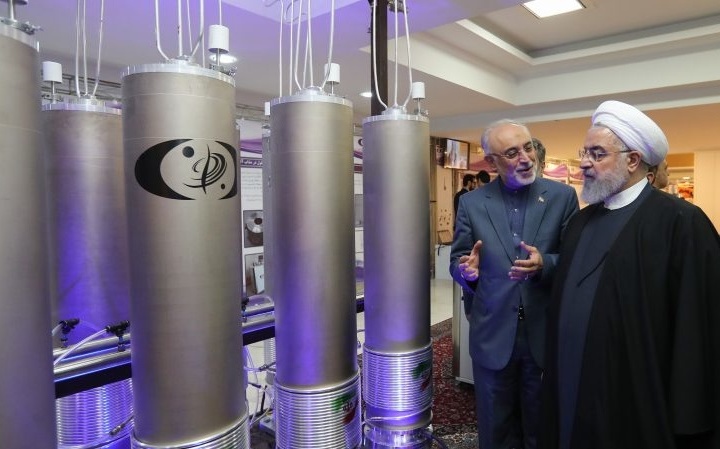President Hassan Rouhani (R) and the head of Iran’s Atomic Energy Organization Ali Akbar Salehi inspecting a nuclear plant, Tehran, April 9, 2019
UPDATE, 0845 GMT:
In a speech on State TV, President Hassan Rouhani says Iran will begin injecting gas into 1,044 centrifuges at its Fordow plant on Thursday.
Rouhani cushioned the further suspension of Iran’s commitments under the 2015 nuclear deal by saying that they are reversible and that Tehran will adhere to all terms when other signatories do the same.
We know their sensitivity with regard to Fordow. With regard to these centrifuges, we know. But at the same time when they uphold their commitments, we will cut off the gas again….
We can’t unilaterally accept that we completely fulfill our commitments and they don’t follow up on their commitments.
The President did not explain which commitment were not being observed by the remaining 5+1 Powers (UK, France, Germany, China, and Russia), but he has said that Iran will continue suspensions unless the European Union offers an acceptable mechanism to bypass US sanctions.
ORIGINAL ENTRY: In a further suspension of the 2015 nuclear deal with the 5+1 Powers, Iran has deployed advanced IR-6 uranium centrifuges.
During a ceremony at the Natanz uranium enrichment facility, the head of the Atomic Energy Organization, Ali Akbar Salehi, said gas is being injected into the centrifuges “making operational a 30-machine cascade”.
Salehi said Iran now has 60 operational IR-6 machines. He claimed production of enriched uranium is now 5 kg per day, compared with 450 grams in September.
At the time of the 2015 agreement with the 5+1 Powers (US, UK, France, Germany, China, and Russia), Iran was operating IR-2m centrifuges and pursuing faster IR-4 and IR-6 machines.
Under the deal, research and development was strictly limited, but Donald Trump withdrew from the agreement in May 2018 and US comprehensive sanctions followed in November. Iran then threatened to suspend its commitments, particularly if economic links with Europe could not be established to bypass the sanctions.
Since late June, the Rouhani Government has exceeded the deal’s limit on stocks of 3.67% enriched uranium, raised enrichment to 4.5%, and installed the advanced centrifuges. In September, it said 20 IR-4s and 20 IR-6s were in place.
Iran has yet to return to its pre-2015 production of 20% uranium, which can be further enriched to 90% grade for use in a military nuclear program.
In February, the European Union launched a mechanism, INSTEX, to bypass US sanctions. But Tehran rejected the link because of “humiliating conditions” such as criticism of the Iran’s missile program, its activities in the Middle East, and its alleged involvement in assassination and bomb plots in Europe.
On Sunday, the Supreme Leader ruled out any negotiations with the Trump Administration and belittled the efforts by French President Emmanuel Macron at mediation between Iran and the US.
See Iran Daily, Nov 4: Supreme Leader Says No Talks With Trump, Belittles Macron
The European Union said on Monday that it “took note” of the Iranian announcement but will wait for confirmation by the International Atomic Energy Agency before responding.
Maja Kocijancic, the spokesperson for the European Commission, said:
We have continued to urge Iran to reverse such steps without delay and to refrain from other measures that would undermine the nuclear deal. But we have also been consistent in saying that our commitment to the nuclear deal depends on full compliance by Iran.
We have been consistently expressing our concerns since we believe that the JCPOA [Joint Comprehensive Plan of Action] should be preserved, it’s a matter of our security, not just the region or Europe but globally.
German Foreign Minister Heiko Maas challenged Tehran, “Iran has built very advanced centrifuges, which do not comply with the agreement….We think this is unacceptable.”

